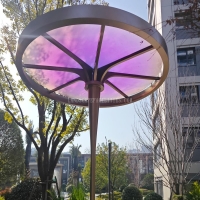Welcome to the website for landscape facilities products and knowledge.
How does the table’s design support ease of use in outdoor relaxation spaces?
A well-designed outdoor table serves as the centerpiece of any relaxation space, transforming simple patios and gardens into functional sanctuaries. The fundamental elements supporting ease of use begin with material selection. Modern outdoor tables utilize weather-resistant substances like powder-coated aluminum, teak wood, or synthetic wicker that withstand seasonal changes while requiring minimal maintenance. These materials eliminate the constant worry about sudden rain showers or intense sun exposure, allowing homeowners to leave furniture outside year-round.
Beyond durability, ergonomic design principles significantly enhance comfort. Tables with rounded corners prevent accidental bumps during movement, while slightly tapered edges provide comfortable arm resting positions during long conversations. The ideal height—typically between 28-30 inches—matches standard chair and sofa seating, creating seamless transitions between sitting and standing positions. This attention to human factors reduces physical strain during social gatherings or solitary relaxation moments.
Functional integration separates exceptional outdoor tables from merely adequate ones. Many designs now incorporate built-in features like central fire pits, ice buckets, or removable cutting boards that consolidate entertainment functions. These multifunctional elements reduce the need for additional accessories cluttering the space. Furthermore, tables with adjustable components—such as expandable surfaces or convertible heights—accommodate varying group sizes and activities, from intimate coffee sessions to larger family barbecues.
Mobility considerations further support effortless usability. Lightweight construction combined with sturdy frames enables easy repositioning to follow shade patterns throughout the day or create new conversation areas. Some designs incorporate locking wheels that provide stability on uneven surfaces while maintaining relocation flexibility. For permanent installations, tables with anchored bases withstand wind without requiring constant securing and releasing.
Surface design details contribute significantly to practical use. Textured tops prevent glassware slippage during breezy conditions, while integrated drainage channels in center panels allow quick water runoff after rainfall. The growing popularity of multilevel designs creates designated zones for different items—keeping food separate from drinks and personal devices—while maintaining clear sightlines across the table.
Ultimately, successful outdoor table design harmonizes aesthetic appeal with pragmatic solutions. The combination of durable materials, human-centered dimensions, integrated features, and mobility options creates furniture that disappears into the background of relaxation rather than demanding constant attention. This thoughtful approach to outdoor table design transforms ordinary exterior spaces into effortless extensions of indoor living areas, where the focus remains on enjoyment rather than maintenance or adaptation to furniture limitations.
Related search:

Recommendation
Metal frame with gradient color acrylic combined with high-end shading landscape facilities